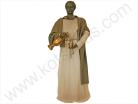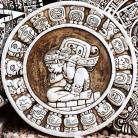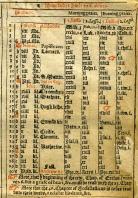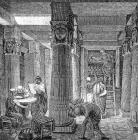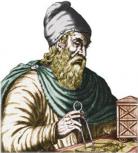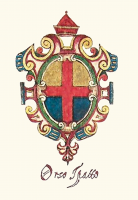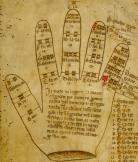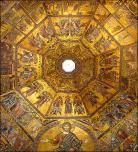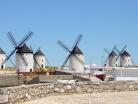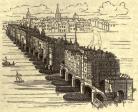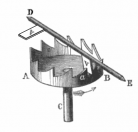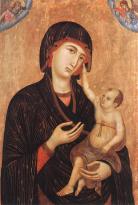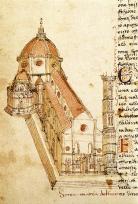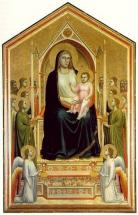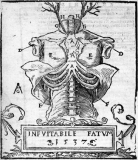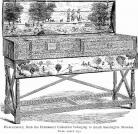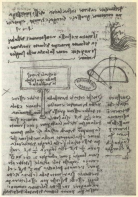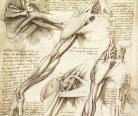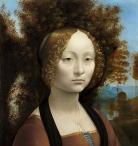Purdue Honors College Leonardo da Vinci Timeline
Created by Dino Franco Felluga on Thu, 01/25/2018 - 15:48
Part of Group:
This timeline, tied to HONR 299: Leonardo da Vinci at Purdue University, explores various aspects of Leonardo's career, as well as the transition from the medieval period to the Renaissance (and beyond).
Timeline
Chronological table
| Date | Event | Created by | Associated Places | |
|---|---|---|---|---|
| circa. 1 |
The Autonomous Servant of PhilonThe servant of Philon is a humanoid robot from the 3rd century BC designed to pour and mix wine and water whenever a cup was placed in the statues hand. The robot first pours the wine, and then dilutes it with water, using pipes hidden within the robot leading up its arm and into its central chamber, around where the stomach would be. Flow is started or stopped by opening and releasing air valves above the fluid reservoirs, which allowed or prevented flow by causing a vacuum. Placing the cup into the robot's hand would cause the arm to lower and the air valves to open; as it poured the robot would lower and eventually the air valve would close again. Image and Information Source: http://kotsanas.com/gb/exh.php?exhibit=0401001 No Author. "The Automatic Servant of Philon" Kotsanas Museum. Retrieved 8 March 2018 |
Joshua Walker | ||
| circa. 1 |
Mayan CalendarThe Mayan Calendar can be traced back to ancient cultures in Central America around 2000 BCE. The calendar was further refined by the Mayan civilization, and some descendants of the Maya still use the calendar today. The Mayan calendar actually consists of 3 separate calendars. It is likely that the Mayan Tzolkin calendar was originally developed around the cultivation of corn, which was a major part of Mayan culture. Tzolkin comes from the Mayan words tzol, "to put in order" and kin, "day". The Tzolkin calendar aligned the Mayan growing season with the seasons of the Earth and the rains using their growing system, la milpa. The calendar was based on the number of digits on the hands and feet, 20, which is designated as a kal. 20 periods of 13 days, or 260 days, constituted one growing season, and thus the Tzolkin calendar was created. This calendar was also used to time religious and ceremonial events in Mayan culture. The Maya later developed a solar calendar, based on the time it takes for the Earth to orbit the Sun, called the Haab. This 365 day calendar consists of eighteen 20-day months and a single 5-day month. Each month is associated with a particular personality trait. This calendar is exactly 365 days long, which causes problems when aligned with the Earth's 365.2422 day solar year. The familiar Mayan Long Count is used to track longer periods of time. This astronomical calendar consists of a 7885 year cycle, which the Maya believed marked the destruction of the universe and creation of a new one. These three calendars were used in conjunction to keep track of time in the Mayan civilization. Sources: "The Origin of the Maya Calendar." Centro de Estudios del Mundo Maya. 2002. http://www.mayacalendar.com/mayacalendar/origen.html. Accessed 7 Mar 2018. "How Does the Mayan Calendar Work?" 2018. https://www.timeanddate.com/calendar/mayan.html. Accessed 7 Mar 2018. Image: Wikipedia Commons, public domain. https://commons.wikimedia.org/wiki/Haab_calendar |
Derek Jones | ||
| circa. 1 |
Roman CalendarThe Roman calendar, also known as the lunar calendar, was probably created by Romulus himself around 753 BCE. The calendar had 10 months from Martius (March) to December. The winter season was not part of any month and therefore 61 days were not included in the calendar. The recorded 304 days were broken into six 30-day months and four 31-day months, based on the cycles of the moon. Calends (from the Greek καλειν “to announce”) were the first day of the month, matching with the “announcement” of the new moon. Nones marked the half moon and were 8 days before the Ides, which were halfway through the month on the day of the full moon. Dates were referenced to these 3 days each month. Because this calendar was 304 days long, it quickly misaligned with the seasons. Around 700 BCE, King Numa Pompilius amended the calendar by shortening the months slightly and adding the months of Ianuarius (January) and Februarius (February), increasing the calendar to 355 days. Occasionally, the pontifex maximus of Rome would add an intercalary month between February and March to realign the calendar with the solar year. Source: “The Roman Calendar.” 2018. https://www.timeanddate.com/calendar/roman-calendar.html. Accessed 7 Mar 2018. Image: Wikipedia Commons, public domain. https://commons.wikimedia.org/wiki/Category:Roman_calendar_(pre-Julian_calendar) |
Derek Jones | ||
| 1 |
Julian CalendarThe Julian Calendar replaced the Roman Calendar in 45 BCE on the order of Julius Caesar. Caesar, frustrated with the inaccuracy of the Roman lunar calendar, called upon Sosigenes, an Alexandrian astronomer, to create a solar calendar, based on the Earth’s revolution around the Sun, about 365.242 days. The common year of the Julian calendar is 365 days divided into 12 months. Every fourth year is a leap year, with a leap day added to the last month of the year, Februarius. However, this is too often for leap years to occur, and even this more accurate calendar fell out of sync with the Earth’s solar orbit. This caused important holidays and religious events, such as Easter, to fall several days off of an equinox or solstice. Additionally, the first few decades of the Julian calendar were run under a calculation error, causing a leap year every third year, which only exasperated the problem. Despite these flaws, this calendar was still the most accurate measurement of time in the Roman empire and the Western world. Even when these errors were corrected by the Gregorian calendar, many orthodox churches still choose to continue using the Julian calendar even through to today. Source: “The Julian Calendar” 2018. https://www.timeanddate.com/calendar/julian-calendar.html. Accessed 7 Mar 2018. Image: Wikipedia Commons, public domain. https://commons.wikimedia.org/wiki/Julian_calendar |
Derek Jones | ||
| circa. 1 |
Ancient Ball BearingsWhile da Vinci worked on improving ball bearings in the late 15th century, their appearance in history dates back to ancient times with societies including the Romans and Chinese. While prehistoric civilizations show no use of rollers to move heavy objects, early civilizations displayed a clear knowledge of the advantages of rolling as opposed to sliding. The Romans showed clear evidence of using rollers as early as 900 B.C. Rollers were commonly used when moving large stone columns for architecture purposes. Other archeological finds show the use of rudimentary thrust bearings (bearings that can handle both an axial and radial load), as well as objects who’s uses can only be speculated. The Chinese also displayed use of rolling elements. Annular bronze objects which contained a number of internal compartments have been found that date back to 100 B.C. While the use of such objects remains unknown, it is strong evidence that China was also investigating the advantages of rolling over sliding. In contrast, there were no advances in roller technology during the Middle Ages. It is not until the Renaissance that inventors such as da Vinci focus on making many of the advances that have led to bearing technology today. Source: Dowson, Duncan, and Bernard J. Hamrock. History of Ball Bearings. 1981. Image: Dowson, Duncan, and Bernard J. Hamrock. History of Ball Bearings. 1981.
|
Katelyn Polson | ||
| circa. 1 |
Ancient Egyptian Anatomical StudiesLeonardo made several extremely important discoveries that directly contradicted prevailing scientific beliefs of the time, such as the concept that the heart defined the circulatory system, and not the liver. However, such discoveries had been made many centuries previously by the Ancient Egyptians, whose forays into embalming the human body allowed them to recognize the presence and location of several major organs, including the heart, the liver, the spleen, the kidneys, the uterus, the bladder, and even the hypothalamus as early as 1600 BC. The Ebers Papyrus, published c. 1550 BC, contained a much more detailed treatise on the anatomy and location of the heart that also placed it at the center of the circulatory system. However, the Ancient Egyptians failed to realize the separation of the circulation of blood from the circulation of other fluids, and also credited vessels connecting to the heart with carrying substances like urine, semen, and tears. Sources: Image from: https://commons.wikimedia.org/wiki/File:EdSmPaPlateVIandVIIPrintsx.jpg |
Shelly Tan | ||
| circa. 124 |
Construction of the Roman PantheonCompleted circa 124 BC, the pantheon was commissioned by Marcus Agrippa as a temple to worship all gods. This temple is particularly unique in the size and construction of its domed cupola, which spans 43m, making it the largest unsupported concrete dome in existance. While modern engineers have been able to determine that the dome owes its size, strength, and longevity to concrete mixes of different densities and thicknesses as well as the circular oculus at its peak which reduced the overall weight of the structure, this knowledge was lost in the intermittent Medieval and Renaissance periods. While many architects drew inspiration from the architecture of this building, without the structural knowledge needed to combat hoop stresses within a dome this size, the Pantheon's cupolla remained unparalleled for roughly 1200 years until the completion of the Duomo in Florence. “The Pantheon.” The Roman Pantheon: the Triumph of Concrete, by David Moore, MARC/CCEOP, University of Guam Station, 1995. Image courtesy of https://commons.wikimedia.org/w/index.php?curid=175842, Public Domain |
Stephanie Andress | ||
| circa. 150 |
PtolemyClaudius Ptolemy was born in 100 AD and soon became one of the most influential Greek astronomers and geographers of his time. Ptolemy lived in Rome and studied under a mathematician known as Theon of Smyrna, who had written on astronomical observations such as conjunctions, eclipses, occultations, and transits. It is known that Theon did not have any depth of understanding of his observations, but his influences can be seen in the work of Ptolemy. It is argued that Ptolemy’s greatest work was a book titled “The Almagest”, and is considered a mathematical compilation. It is thought to be one of his earliest works and details the mathematical motions of the sun, the moon, and the planets. He made his most original contribution by detailing the motions of the celestial bodies in the universe. His goal was to continue the work given by those who came before him, not to prove or disprove any information he was previously taught. With this in mind he continued the work of Aristotle who stated that the Earth was the center of the universe and that the other celestial bodies orbit the Earth. Ptolemy used geometry to describe/predict the motion of other celestial bodies using eclipses. He introduces trigonometrical methods based on the chords method. His discoveries were widely accepted and prevailed for 1400 years. Source: Robertson, E and O'Connor, J. "Ptolemy Biography." University of St. Andrews. April 1999. http://www-groups.dcs.st-and.ac.uk/history/Biographies/Ptolemy.html. Accessed 15 Mar. 2018. Image source: Wikipedia Commons, Public Domain. https://commons.wikimedia.org/wiki/File:PSM_V78_D326_Ptolemy.png |
Rachel Lee | ||
| circa. 158 |
GalenMost of the prevailing anatomical beliefs of da Vinci's time were courtesy of Galen's work. Active mainly in the 2nd century, Galen both compiled existing medical knowledge and sought to further expand it through dissection of animal specimens (as dissection of human corpses was forbidden). These findings were broadly applied to human anatomy as the closest possible parallel, and were leveraged in Galen's work as chief physician to Pergamum's gladiators in 158. His discoveries included the refinement of the anatomy of the trachea (inclding the idea that the voice is generated in the larnyx), the clarification of a difference between venous and arterial blood, and the refinement of techniques for eye and brain surgery (most notably cataracts) that would not been seen again for centuries. His work, however, was not without errors, as most animal models were not in fact close parallels to their human counterparts, as he believed. The differences between venous and arterial blood also led him to the conclusion that the circulatory system was composed of two one-way halves, one beginning in the liver and one in the heart, as opposed to a single, unified whole. He also championed the Hippocratic notion of humors, suggesting an anatomical basis for emotion and personality. Da Vinci's work with human cadavers would later refute all of these errors, despite his also possessing an intial support for humoral theory; a lack of evidence for Galen's hypotheses would convince Leonardo to eventually depart from Galenic theory altogether, and rely solely on his own empirical observations. Sources: Image from https://en.wikipedia.org/wiki/File:Claudius_Galenus_(1906)_-_Veloso_Salgado.png |
Shelly Tan | ||
| circa. 332 |
City of AlexandriaIn 332 BCE, ~2,300 years ago, Alexander the Great conquered Egypt and established the city of Alexandria on the port town of Rhakotis. Ptolemy, Alexander’s general, moved the capital of Egypt from Memphis to Alexandria where he entombed Alexander’s body after his death in 323 BCE. The city soon became a thriving city attracting many scientists, historians, philosophers, mathematicians, and artists becoming a hub of research and education with the foundation of the Ancient Library of Alexandria in 288 BCE. The Library would eventually house 700,000 scrolls including many autonomy and medical texts. The School of Alexandrian Medicine, established in the 3rd century BCE, would also teach many highly accredited physician who would go on to theorize and discover important works. These works would go on to have extensive influence and importance as credible medical references for over centuries. Alexandria experienced two major fires one in 48 BCE and one in 391 CE which burned down the surviving sections of the Ancient Library of Alexandria and the School of Alexandria Medicine. The two fires combined destroyed almost all of the medical and autonomy texts created in Egypt. The teachings of Alexandria continue to survive through physicians who studied at Alexandria before fire in 391 CE and went on to work in other countries. An example of this is Galen, a famous Roman physician, who studied at Alexandria. His works went on to have extensive influence on medicine during the Renaissance and Leonardo Da Vinci.
Sources: Mark, Jashua. "Alexandria, Egypt". Ancient History Encyclopedia. 28 April, 2011. Serageldin, Ismail. "Ancient Alexandria and the dawn of medical science". Global Cardiology Science & Practice, vol. 4, Dec. 30, 2013:395-404. DOI: PMC10.5339/gcsp.2013.47. March 7, 2018
Image: A 19th century artistic drawing of the Library of Alexandria based off of archaeological evidence. Artist: O. Von Corven Source: Wikimedia Commons *Please Note: The date on the timeline shows 332 CE, but the actual date is 332 BCE. The entry would not be accept the date of 332 BCE for the event date.
|
Amanda Gozner | ||
| circa. 400 to circa. 400 |
Origin of Compound Pulley SystemsThough the invention of the pulleys has not been pinpointed to a certain date or region, the perfection of the compound pulley system to reduce effort and increase mechanical power was done so by the Greeks. In fact, Archimedes is said to have perfected the use of a pulley for a crane and thus creating the first-ever block-and-tackle system. A story retold by many demonstrates his prowess in this. He once claimed, “Give me a place to stand and I will move the Earth” to King Hieron. A ship, that weighed two tons, which was intended as a gift to the Egyptian empire was built however yet to be hauled into the sea. When challenged to do so, Archimedes designed a complex system of compound pulleys, a rotating helix, and ropes, and thus was successful in his task. Sources:- Monahan, John. “Archimedes Coins "Eureka!" in the Nude--and Other Crazy Ah-Ha Moments of Science.” Scientific American, 7 Dec. 2010, www.scientificamerican.com/article/archimedes-coins-eureka/. Archimedes and the Simple Machines That Moved the World." Science and Its Times: Understanding the Social Significance of Scientific Discovery Image Courtesy: Wikimedia Commons, public domain https://commons.wikimedia.org/wiki/File:Archimedes_( ** Note:- Though the timeline states 400 CE, it is in fact 400 BCE. This is because the timeline does not support BCE |
Yamuna Ambalavanan | ||
| circa. 400 to circa. 639 |
Settlement of the Venetian LagoonWhile many myths surround the first Venetians, most historians and archaeologists agree the lagoon and its islands were sparsely populated during the early Roman Empire with fisherman and duck hunters, likely trading with the cities of Aquileia, Altino, and Oderzo on the northern coast of the Adriatic Sea. San Francesco del Deserto, for example – an island in the northern lagoon shown by carbon dating to have first been inhabited in the 5th century – shows evidence of a Roman port where goods from the Adriatic were received and transferred to these towns, several miles west. The populations of these islands, meanwhile, were rather small and likely not year-round.
Between the 4th and 7th centuries, Eastern, Germanic, and Central Asian tribes migrated through Europe and into the territory of the Roman Empire. The Empire, whose fall is often attributed in part to these "barbarians," was not capable of defending northeastern Italy from invasion. As a consequence, the people of the Roman cities in the northern Adriatic, fleeing violence and chaos as these tribes swept through the region, sought safety in the islands of the Venetian lagoon.
Early waves of this migration into the lagoon came with the Visigoths and the Huns, who each sacked the wealthy Roman trading city of Aquileia, the former on their way to Rome in 402, and the latter under the command of Atilla the Hun in 452. In each case, the city's inhabitants fled their attackers, adept horsemen unfamiliar with seamanship, for the sea.
Though these early ventures into the lagoon were somewhat tentative -- with many Aquileians returning to the mainland when the danger passed – large, permanent settlements came in the 6th and 7th centuries with the invasion of the Lombards, a Germanic tribe from Northern Europe that is believed to have offered their military services to the Byzantine Empire in exchange for land in Italy. The Lombards crossed the Alps in 568, conquered the remaining cities of Oderzo and Altino in 639, and established a kingdom that would last until the end of the 8th century, leaving displaced mainland residents to become the first Venetians. Sources: Horodowich, Elizabeth. (Philadelphia). A Brief History of Venice. 2009: Running Press Book Publishers. Image Source: NASA Earth Observatory, via Wikimedia Commons |
Tyler Stagge | ||
| circa. 500 |
Beginning of the Medieval EraAt the start of the Medieval era, music was primarily in the form of plainsong, which is a set of monophonic chants with a free-flowing meter commonly used in religious contexts. The most traditional type of plainsong is the Gregorian chant. One of the most well-known Gregorian chants of this period, Dies irae (composer unknown), was commonly used in Requiem and describes the Last Judgement. Within this piece, the monophonic melody and religious connotations are obvious; this reflects medieval society’s emphasis on conformity and rejection of the individual, as well as the significance of God and religion in everyday life. Sources: - Malcolm Boyd. “'Dies Irae': Some Recent Manifestations.” Music & Letters, vol. 49, no. 4, 1968, pp. 347–356. JSTOR, JSTOR, www.jstor.org/stable/732291. - The Editors of Encyclopædia Britannica. “Gregorian chant.” Encyclopædia Britannica, Encyclopædia Britannica, inc., 14 Nov. 2014, www.britannica.com/art/Gregorian-chant. Image Source: Wikimedia Commons |
Jennifer Liu | ||
| 697 |
Establishment of the Doge in VeniceSince its beginning, Venice operated under the political auspices of Byzantium, the Eastern Roman Empire which persisted well after the fall of its Western counterpart in the 5th century. Given the distance between the two cities, Venice was not ruled directly by the Emperor, but via a local administrative functionary called the Exarch of Ravenna, who oversaw all of the lands of Italy under Byzantine control, and through which Venetians maintained close economic and cultural ties with Byzantium. After a series of local governors called “maritime tribunes” in the 5th century, the first doges were established as singular military rulers to reinforce Byzantium’s power over the Venetian lagoon and protect it against persistent regional threats. While evidence is not complete, the first of these doges – though not generally thought of as so in the history of the Republic of Venice – is believed to be Paoluccio Anafesto, who was elected in 697 and served under Byzantine orders.
Sources:
Horodowich, E. (Philadelphia). A Brief History of Venice. 2009: Running Press Book Publishers.
Image Source: Pietro Marcello, via Wikimedia Commons |
Tyler Stagge | ||
| 727 |
Orso Ipato: The First True Venetian DogeDuring the Iconoclastic Controversy of the 8th and 9th centuries – a dispute within the Byzantine over the use of religious images and icons – Emperor Leo III the Isaurian (717-41) denounced the worship of icons, eventually ordering their prohibition and destruction.
Venice – siding with Rome – opposed this decision. In their opposition, Venetians armed and revolted, subsequently nominating their own doge, Orso Ipato, in 726.
While Paoluccio Anafesto, elected in 697, may have been the first leader in Venice to bear the title (from the Latin dux), he was still a representative of Byzantium. Ipato, by contrast, was the first doge elected without external intervention, and as such is remembered as the first true Venetian doge.
Though Byzantium maintained some level of power in Venice for a period of time, having appointed a number of administrators, its authority entered decline after the middle of the 8th century. Around this time, the Lombards captured Ravenna, the seat of Byzantine power in Italy, and its exarchate leadership subsequently collapsed in 751.
Sources:
Horodowich, E. (Philadelphia). A Brief History of Venice. 2009: Running Press Book Publishers. The Editors of Encyclopaedia Britannica. (n.d.). Iconoclastic Controversy. Retrieved from Encyclopaedia Britannica: https://www.britannica.com/event/Iconoclastic-Controversy
Image Source: http://www.cnicg.net/dogi/, via Wikimedia Commons |
Tyler Stagge | ||
| 810 |
Defeat of the FranksBy the late 8th century, the Lombards were increasingly defeated and supplanted by the Franks, the new prevailing barbarian group in the Europe, ruled by Charlemagne. Already established in Gaul and reckoning himself a new Western Roman Emperor, Charlemagne entered the Italian peninsula, conquered Lombard lands, and incorporated them into the largest territorial empire in Western Europe since the fall of Rome.in 476.
After excising remaining Lombard control over the surrounding coast in 774, Charlemagne declared himself lord of the Venetian lagoon. Venice, however, given its history and politics remained loyal to its ties to Byzantium and resisted Charlemagne’s rule.
Pepin, his son, then attempted to conquer Venice in 810. Though he was successful in taking the territory surrounding the lagoon, destroying Jesolo, Eraclea, and Grado to the east, Pepin was held off at Malamocco.
With their swift, flat-bottomed boats and knowledge of the shallow waters, the Venetians were able to thwart the attack, decimating the vessels of the Frankish fleet, which routinely ran aground. After six months of fighting and still unable to take the inner islands, Pepin accepted a Venetian offer of an annual tribute in exchange for the permanent removal of his forces.
This victory – in addition to a series of treaties with both the Franks and Constantinople between 812 and 840 – would become decisive moments in Venetian history, cementing the city-state’s political independence and growing power.
Sources:
Horodowich, E. (Philadelphia). A Brief History of Venice. 2009: Running Press Book Publishers. FitzSimmons, A. K. (2013, December). The Political, Economic, and Military Decline of Venice Leading Up to 1797. University of North Texas. Retrieved March 2018, from https://search.proquest.com/docview/1650621354?pq-origsite=primo
Image Source:
|
Tyler Stagge | ||
| circa. 850 |
The Discovery of GunpowderWhile trying to discover a potion of immortality, Chinese alchemists of the Tang Dynasty accidentally discovered saltpeter, the main ingredient of gunpowder. Upon further experimentation, saltpeter was combined with charcoal and sulfur. While this combination did not grant everlasting life, it did have excellent flammable and explosive properties when ignited. Gunpowder was initially used by the Chinese for fireworks, however gunpowder was used for war as early as 904 A.D., marking the beginning of a long and deadly history of gunpowder. One of the first effective uses of gunpowder was against the Mongols during the Song Dynasty through "an arrow fixed with a tube of gunpowder that ignited and would propel itself across enemy lines" (Whipps). What was meant to be a potion of life would eventually become the main ingredient for death. Sources: Whipps, Heather. “How Gunpowder Changed the World.” LiveScience, Purch, 6 Apr. 2008, www.livescience.com/7476-gunpowder-changed-world.html. |
Steven Mazzochi | ||
| circa. 1025 |
Creation of the Staff Notation and Guidonian Hand
In 1025, Guido D’Arezzo revolutionized musical notation by creating the four-lined staff, a primitive form of notation that eventually led to the development of the five-lined staff notation still used in modern music today. This development in musical notation was intended to make it easier for individuals to learn, understand, and memorize new compositions; it was also one of the first movements taken in the process of creating a universal standard for written music. In addition to the four-lined staff, Guido is also credited with constructing the Guidonian Hand (more commonly known as the “do-re-mi-fa” mnemonic system), another musical technique used to make the learning of music easier. With both methods, performers were able to associate sound with sight and become more familiar with pitch and mode.
Sources:
- Reisenweaver, Anna J. (2012) "Guido of Arezzo and His Influence on Music Learning," Musical Offerings: Vol. 3 : No. 1 , Article 4. DOI: 10.15385/jmo.2012.3.1.4 Available at: http://digitalcommons.cedarville.edu/musicalofferings/vol3/iss1/4
Image Source: Oxford University, via Wikimedia Commons |
Jennifer Liu | ||
| circa. 1027 |
Ibn al-Haytham's The Book of OpticsThe Book of Optics (Arabic: كتاب المناظر, Kitāb al-Manāẓir) is a seven volume treatise by Abu Ali al-Hasan ibn al-Haytham, also known as Alhazen. The work explored a variety of topics including light, color, and how the eye works. Most notably, the work looked at intromission and emission, the two common theories about how vision functioned at the time. Like intromission theory, Ibn al-Haytham argued that rays of light were omitted from objects to be perceived by the eye using the cone of vision model. His work in optics helped to shape the theory of perspective through the medieval and Renaissance periods. This set the foundation for present day perspective and working drawings.
Sources: The Institute of Ismaili Studies. “Ibn al-Haytham or Alhazen.” Ibn al-Haytham or Alhazen | The Institute of Ismaili Studies, iis.ac.uk/encyclopaedia-articles/ibn-al-haytham-or-alhazen.
The Pittsburgh Conference on Analytical Chemistry and Applied Spectroscopy, Inc. “The Father of Modern Optics - Ibn al-Haytham's Book of Optics.” AZoOptics.com, 14 July 2017, www.azooptics.com/Article.aspx?ArticleID=925.
Image courtesy of History of Science Collections, University of Oklahoma Libraries. Image is public domain {{PD-1996}}. |
Emily Maneke | ||
| 1059 to 1452 |
St John’s Baptistry & the Gates of ParadiseOne of the oldest buildings in the city, the Florence Baptistry served its titular religious function for notable Florentines including Dante Alighieri and the Medici Family. Besides its important religious role, the Baptistry was also seen as a pinnacle of Florentine art and architecture leading up to the Renaissance. Constructed between 1059 and 1128, the Baptistry exemplifies the Florentine Romanesque style with its façade of white and green marble, geometric panels, domed arches, and octagonal dome. The interior art includes byzantine mosaics depicting traditional religious themes such as the Last Judgement. While representing art from multiple periods across its long life, the Baptistry is often touted as the birthplace of the Florentine Renaissance. This distinction is due to its three sets of bronze doors, particularly the north and east doors completed by Ghiberti between the years of 1401-1452. The artist was commissioned to design bonze panels for north doors after winning a competition against other notable artists including Brunelleschi and Donatello. After gaining acclaim for the realistic and emotion filled depictions of the New Testament scenes on these doors, the artist received a commission for the east doors, which were so magnificent they were dubbed “The Gates of Paradise” by Michelangelo and were later recognized as the foundation of Renaissance sculpture. “Baptistry of San Giovanni.” Il Grande Museo Del Duomo, www.museumflorence.com/monuments/3-baptistry. Levinson, Gilon. “ Florence, Baptistry: Colored Accents, Designer Doors.” Architecture Past Present & Future, 2009, www.architectureppf.com/chapter_6/Florence_Baptistry.aspx. Image: By Ricardo André Frantz (User:Tetraktys) (taken by Ricardo André Frantz) [CC BY-SA 3.0 (https://creativecommons.org/licenses/by-sa/3.0)], via Wikimedia Commons https://commons.wikimedia.org/wiki/File%3AFlorenca133b.jpg |
Stephanie Andress | ||
| 1086 |
Watermills of Medieval EuropeWatermills have been in existence since antiquity. Evidence exists for their use, by both the Romans and the Greeks, and from them the technology was spread throughout Europe. Vitruvius, the classical architect who would so greatly influence Leonardo da Vinci, created the first known diagram of a Watermill. By the middle ages, this technology was ubiquitous. The date of this event refers to the year of the Domesday book, a proto-census of England. The book showed, among other things, that in England alone there were 5,624 watermills, a number that would increase in the coming centuries. Thus when Leonardo experimented with watermills, it was an immensely practical study, one that could impact the lives of people across the continent. Overwhelmingly, these mills were used to grind grain, a staple of the European diet. However, in some cases there is evidence that the mills were used to power other industries, and this seemed to be increasingly the case as time went on. Leonardo’s own work would focus on expanding possible uses for the mill. The water mill, was one of the most important pieces of medieval machinery. Thorkild Schhøler (1989) The Watermills at the Crocodile River: A Turbine Mill Dated to 345–380 a.d., Palestine Exploration Quarterly, 121:2, 133-143 https://en.wikipedia.org/wiki/Watermill#CITEREFGimpel1977 Picture by Pierre 79, retreived from Wikimedia Commons, fair use |
Ian Campbell | ||
| 1095 to 1291 |
CrusadesThe Crusades were a series of religious wars between Christians and Muslims over the land of Palestine. During the time of the Crusades, the East was more advanced than Europe in terms of civilization. The knowledge gained by crusaders included new advancements in science that helped liberate the minds of Europe. The mental activity that resulted created the final intellectual outburst of the Renaissance. The Crusades also helped to establish Venice as a wealthy center for trade, which increased its power and reputation. The Crusades were a turning point for Europe, exposing them to new discovery and undermining feudalism. Sources: “The Crusades.” History.com, A&E Television Networks, 2010, www.history.com/topics/crusades. “Effects of the Crusades.” Lords and Ladies, www.lordsandladies.org/effects-of-crusades.htm. Image Source: The Crusades, 1337. https://en.wikipedia.org/wiki/Crusades |
Laila Kassar | ||
| circa. 1100 |
Establishment of St. Martial School - Limoges, France
The establishment of St. Martial school marked a turning point in medieval music; it’s creation depicted the transition from purely monophonic music to polyphonic. The introduction of polyphony arose in tandem with developments in art, science, and philosophy; one could even argue that the advancements in the latter subjects catalyzed the evolution observed in music. St. Martial school is widely recognized for its teaching of organum, an early form of polyphony, and was influential in the formation of the Notre Dame school of polyphony in 1160. Contrary to the name, the Notre Dame school was not a physical institution, but a group of composers that experimented with organum and developed polyphony, the most notable composers being Leonin and Perotin.
Sources:
- The Editors of Encyclopædia Britannica. “Organum.” Encyclopædia Britannica, Encyclopædia Britannica, inc., 12 Nov. 2010, www.britannica.com/art/organum.
- “Saint Martial school.” Wikipedia, Wikimedia Foundation, 17 Feb. 2018, en.wikipedia.org/wiki/Saint_Martial_school.
Image Source: Paris, Bibliotheque Nationale, via Wikimedia Commons |
Jennifer Liu | ||
| circa. 1150 to circa. 1250 |
Windmills in Medieval EuropeAlthough windmills had already been in use in the Middle East for centuries, they were not introduced into Europe until sometime in the 13th century. There is some debate as to whether or not this technology, like so many other late medieval innovations, was brought back from the Middle East as a result of the crusades. Windmills, like watermills were a vital part of everyday life, being used to pump water, to saw wood, and to grind grain. Especially this last use was incredibly important as it allowed those who did not live near a river to grind their grain far more efficiently, by saving them from grinding by hand, or having to transport the grain to a distant mill. While this innovation occurred before the Renaissance proper, and outside of Italy, it bore with it many similarities to renaissance innovations, such as a desire to utilize the knowledge of non-Christian cultures, as well as to create things of practical worldly use. Leonardo’s work with water power thus, was happening in an era full of innovations in the field of making nature work for mankind. Pelikan, Bob. "Windmills." National Driller 31, no. 2 (2010) 12, 14, 16. Image created by , retrieved from Wikimedia Commons, Fair use |
Ian Campbell | ||
| 1176 to 1209 |
Old London BridgeIn 1176, Peter of Colechurch began constructing London Bridge, now referred to as Old London Bridge, over the River Thames. Completed in 1209 shortly after Peter's death, the stone bridge served as a commercial crossing that housed both businesses and residences. The bridge consisted of a wooden drawbridge centered between 19 ogive arches spanning 15 to 34 feet. It wasn't until Old London Bridge was replaced in the 1820s that a span of over 100 feet helped bridge the Thames. Sources: Billington, David P. “Bridge Engineering.” Encyclopædia Britannica, Encyclopædia Britannica, Inc., 2 Aug. 2017, https://www.britannica.com/technology/bridge-engineering/The-Middle-Ages. ---. “London Bridge.” Encyclopædia Britannica, Encyclopædia Britannica, Inc., 7 May 2013, www.britannica.com/topic/Old-London-Bridge. City Bridge Trust. “History.” City Bridge Trust, www.citybridgetrust.org.uk/about-us/history/. The image is public domain {{PD-UK-unknown}}. |
Emily Maneke | ||
| circa. 1200 |
Rebirth of Human DissectionThere was a rebirth of human anatomical dissection during the middle ages. This occured for a couple of reasons. The first being there was a change in ideology around the body. The ideology shifted towards a belief that the human body and the human soul were two seperate things. So when a person died the soul had no connection to the body after death. This change eliminated the christian religious limitation which had been placed on dissection of humans. The second shift is an increased interest in medicine during this time period. Like during the renaissance there is a increased interest and increased scientific mindset during the end of the medieval period. This allowed for the increased desire to participate in medical endeavors. The third is a shift in ideology around how a cadaver should be handled. During the middle ages it was not uncommon for cadaveres to be dismembered. Nobles and kings even had there bodies dismembered, saltered, or even boiled after death. This allowed for more access to bodies than had previously been available legally. Due to the resurgence of human dissection in the Middle Ages Leonardo Da Vinci was able to do extensive work with dissection of humans and animals throughout his lifetime. He would use the knowledge he gain during the autopsy for not just anatomical and physiological knowledge, but to more accurately paint human figures.
Source: Prioreschi, P. “Determinants of the Revival of Dissection of the Human body in the Middle Ages.” Medical Hypotheses 2001.Vol 56 (2):229-234. DOI:https://doi.org/10.1054/mehy.2000.1183. Accessed March 8, 2018
|
Amanda Gozner | ||
| circa. 1250 to circa. 1299 |
Verge EscapementSometime in the late 13th century, the verge and foliot assembly, also known as a verge escapement, was invented in Europe. This mechanism used an oscillating gear and a balance wheel to turn a shaft in small, equal amounts at a steady rate. This was a major advancement for mechanical technologies, as this allowed for mechanical clocks to be constructed. These clocks were more accurate than previous methods of time measurement such as water clocks, sundials, and marked candles. Additionally, they were more reliable and required less maintenance. Although more advanced mechanical escapements were created in the following centuries, this was the first mechanical device that let man create his own time, rather than let nature determine time for him. Soon, this new technology was put into use in town clocktowers around Europe, especially England and Italy. One of the earliest mechanical clocktowers was believed to be constructed in the Palace of the Visconti in Milan, Italy, in 1335 AD. This new method of timekeeping spread quickly across Europe and enabled societies to agree on the time of day with relative accuracy, influencing how social events and daily lives alike were conducted. Sources: Wade, Caleb. “The Verge Escapement.” Gearhead. 2018. https://gearhead.engineering/the-verge-escapement. Accessed 8 Mar 2018. Lienhard, John. “The First Mechanical Clocks.” Engines of Our Ingenuity. 2000. https://www.uh.edu/engines/epi1506.htm. Accessed 8 Mar 2018. Image: Wikipedia Commons, public domain. https://commons.wikimedia.org/wiki/File:Verge_Escapement.png |
Derek Jones | ||
| circa. 1283 to circa. 1284 |
Duccio's Madonna and Child with Two AngelsDuccio di Buoninsegna's rendition of the classic piece Madonna and child displays the changing paradigms of Byzantine and Renaissance art. Returning to the idea of anagogic space, Duccio makes use of the gold background and angels in the upper corners to maintain the Byzantine ideals of religion being set about the material world. However, he does drop the two-dimensional halos so often found in Byzantine artwork. The gold background does detract from the Renaissance ideals of realism and depth, but Duccio manages to encompass an emotion within the expression and movements of the woman and child that is rarely seen within Byzantine art. Their faces, extremely individualized as compared to previous style, represent a more affectionate relationship as one might see between a mother and child than can be seen in the traditional Madonna and Child which focuses more on religious symbology than on any form of realism. Duccio's combination of new and old ideals displays how he was painting in the midst of this shift in paradigms, and how often times changing art styles is an exceedingly long process which often has reversions to old practices and values. Sources: Belting, Hans. “The ‘Byzantine’ Madonnas: New Facts about their Italian Origin and Some Observations on Duccio.” Studies in the History of Art 12 (1982): 7-22. JSTOR. Web. 25 Feb. 2018. Stubblebine, James H. “Byzantine Influence in Thirteenth-Century Italian Panel Painting.” Dumbarton Oaks Papers 20 (1966): 85–101. JSTOR. Web. 25 Feb. 2018. Image Source: Image courtesy of https://www.wga.hu/html_m/d/duccio/various/2crevole.html |
Ally Geoffray | ||
| 1288 |
Hospital of Santa Maria NuovaThe Hospital of Santa Maria Nuova was founded in 1288 by Folco Portinari, following the urging of his family matriarch. Over the centuries, the institution would become increasingly rich and powerful due to donations of both money and artwork, receiving even a visit from Pope Martin V in 1419. This hospital would, around 1507, provide the location and resources needed for da Vinci to perform his careful and thorough dissections of human cadavers, including an elderly gentleman whose death he personally witnessed. In the time he worked at this institution, Leonardo would dissect upwards of 30 corpses, using techniques such as wax modeling to observe the anatomy of the cranial cavities, and creating glass replicas of the aorta to study fluid flow. Sources:
|
Shelly Tan | ||
| circa. 1294 to circa. 1436 |
Construction of the Florence CathedralSanta Maria del Fiore, or the Florence Duomo, was constructed over the course of over 140 years under the supervision of multiple head architects. The cathedral was commissioned by the Florence city council in order to replace an ageing church dedicated to Saint Reparata. The initial designs of the cathedral were completed by Arnolfo di Cambio, however, after his death these plans were modified and enlarged. In 1366 final designs for the nave were finalized by a committee of artists and artisans. During this period, two factions formed: those in favor of a smaller, more conservative dome, and those in favor of a larger dome seen as "the more honorable" and "the more magnificent" option. This more daring plan was decided upon, ensuring Florence would have the largest and most magnificent church in Europe at the time. However, the size of the cathedral as well as its irregular octagonal knave posed a significant problem for the completion of the structure. While the main structure of the nave was completed by 1380, a solution to constructing a dome to top it was not determined until 1418. “ Florence Cathedral in 1392.” On Architecture, Columbia University, www.learn.columbia.edu/ma/htm/sw/ma_sw_prim_flor_cath_1392.htm. “Florence Cathedral.” Wikipedia, Wikimedia Foundation, 28 Feb. 2018, en.wikipedia.org/wiki/Florence_Cathedral. “Florence Cathedral.” Archinomy, www.archinomy.com/case-studies/946/florence-cathedral. image courtesy of http://www.travelingintuscany.com/engels/firenze/santamariadelfiore.htm |
Stephanie Andress | ||
| 1297 |
The Serrata of the Great CouncilTowards the end of the 13th century, many of the polities of central and northern Italy came to political settlements to resolve decades of unrest between nobles, merchants, artisans, and the rest of the people. In 1293, Florence passed the "Ordinances of Justice," establishing its guild-centric republican government, while Padua and Ferrara chose monarchical rule. Venice, meanwhile, after the civil consternation that resulted in riots in 1266 and 1275, passed the "Serrata," or Closing, of the Great Council in 1297, generally understood as constitutional legislation that cemented the republican system and defined the families that constituted the ruling class of nobles. The Great Council itself, created in 1142, held no direct power, but elected members of the nobility to nearly every position within the government. Every senator, ambassador, judge, as well doge himself was chosen by the Council. Originally with only 35 members, the body grew in size into the hundreds and even thousands over the coming centuries along with the population of the noble class. The Serrata, which closed the Council to those not of the ordained families, has come to be seen more in its historical context, less of a discrete, decisive event – which plays to the mythology of the Venetian Republic, which came to its end 500 years later in 1797 – and more as the cumulative result of a decades-long process that saw the expansion and delineation of the nobility as well as the tempering of the “populo.”
Sources:
FitzSimmons, A. K. (2013, December). The Political, Economic, and Military Decline of Venice Leading Up to 1797. University of North Texas. Retrieved March 2018, from https://search.proquest.com/docview/1650621354?pq-origsite=primo Rosch, G. (2000). The Serrata of hte Great Council and Venetian Society, 1286-1323. In J. J. Martin, & D. Romano, Venice Reconsidered: The History and Civilization of an Italian City State, 1297-1797 (pp. 67-88). Baltimore: The Johns Hopkins University Press. Image Sources: Sailko, under Creative Commons use, via Wikimedia Commons |
Tyler Stagge | ||
| circa. 1300 |
HumanismHumanism is an ideology which increased in popularity during the Renaissance. The humanistic ideology developed from the increased interest in classical (greek, roman, and latin) texts during the late stages of the transition period between the medieval and renaissance periods. The ideology began in Florence, Italy and began to spread into the rest of Europe in the 16th century. The humanistic ideology places emphasis on “human dignity, beauty and potential” (New World Encyclopedia). This ideology places less emphasis on the church and more emphasis on the ability of an individual person. Humanism had vast influence on many aspects of renaissance culture. In music the compositions became more varied and had more movement. The compositions shifted away from a clerical sound to one more focused on entertainment. In art there was an increased placement of anagogic figures in non-anagogic space. There is also an increased value and importance shown to the human body with multiple detailed drawings being created from artists such as Leonardo Da Vinci. There is an increased emphasis on the beauty of a person which would have been considered humbiris in the past. There is also an increased presence of Roman and Greek architecture which not only a depiction of the interest in greek and roman classical scholars, but also a shift away from christian religion into the presence of a pagan religion in art. In philosophy and education there is an increase importance of truth, reason, and logic.
Source: “Humanism.” New World Encyclopedia. Jan 19, 2018. Accessed March 8, 2018 |
Amanda Gozner | ||
| 1302 to 1359 |
Giotto's CampanileConstructed between 1302 and 1359, Giotto’s Campanile is one of the best examples of the Florentine Gothic style of Architecture in the city. The bell tower is overlaid with red, green and white marble similar to the other structures in the Piazza del Duomo and is characterized by its many geometric panels and carved lozenges. Additionally, the top levels of the bell tower were designed to increase in size at higher levels, using forced perspective to make each level appear the same size. The sculptural artwork on the exterior of the Campanile is particularly of interest as well because, as each new level of the tower was constructed, the clear shift in artistic stylings from a variety of periods is shown. The lowest level uses bas (low) relief to depict the creation of man. The next set are created on blue backgrounds in what is considered a nod to the backgrounds often used in Giotto’s paintings and show themes such as “The cardinal virtues” and “The Liberal Arts”. Above that are several levels of statues ranging from the stylized Byzantine forms of Andrea Pissano to the realistic and individualized renaissance sculptures of Donatello. The Bell tower demonstrates the clear shift in Medieval to Renaissance not only through the progression of art styles, but also through the themes these works depict, which is laudatory of human creativity and creation. Trachtenberg, Marvin. The Campanile of Florence Cathedral: "Giotto's Tower.". New York, New York University Press, 1971. “Giotto's Bell Tower.” Il Grande Museo Del Duomo, www.museumflorence.com/monuments/4-bell-tower. Image: By Julie Anne Workman (Own work) [CC BY-SA 3.0 (https://creativecommons.org/licenses/by-sa/3.0)], via Wikimedia Commons https://commons.wikimedia.org/wiki/File%3AGiotto's_campanile-263.jpg |
Stephanie Andress | ||
| 1310 |
The Council of TenEstablished in 1310 with the intent to preserve the peace and protect the people from abuses of power, the Council of Ten gained power throughout the early 14th century, rapidly becoming a “chief force of justice” (FitzSimons). The members of the Council of Ten – like the Doge, all the members of the Senate and courts, and other government officials – were elected by the Great Council. In addition to those members, the Signoria – which includes the three chiefs of the Quaranta Criminale court, the six Ducal Councilors, and the Doge – were present at all meetings. Among its purposes, the Council worked to counter any actions or plots that may be taken or made against the Republic. The body’s small size facilitated this role, enabling it to make quick decisions in relative secrecy. In 1319, The Council established its own police force, the Capi di Sestiere, which along with two previous forces, patrolled the six political divisions of Venice, pursuing criminals and enemies of the state alike. As such, the Council of Ten, along with the courts and heavy taxes, played an important role in preventing popular rebellion and maintaining peace and order.
Sources: FitzSimmons, A. K. (2013, December). The Political, Economic, and Military Decline of Venice Leading Up to 1797. University of North Texas. Retrieved March 2018, from https://search.proquest.com/docview/1650621354?pq-origsite=primo Horodowich, E. (Philadelphia). A Brief History of Venice. 2009: Running Press Book Publishers. Image: Created based on the information provided by the source above. |
Tyler Stagge | ||
| circa. 1310 |
Giotto di Bondone’s Ognissanti MadonnaGiotto di Bondone’s Ognissanti Madonna, or Madonna Enthroned, is a tempera on panel which is currently housed in Uffizi Gallery of Florence, Italy. Although currently housed in a gallery, this painting was originally designed to be placed on the high alter for the Ognissanti Franciscan church in Florence. The painting itself represents a conglomerate of painting styles and techniques. The gold and flattened background harkens to the Byzantine style or religious symbology and anagogic space. The icons themselves, Madonna and the Child, also appear stiff and stylized, even made larger in an unrealistic scale difference from the rest of the piece to display their distinction from the material world even further. However, Giotto’s technique is advanced in that he managed to represent a more lifelike rendition of three-dimensionality than usually seen in the Byzantine style. Giotto uses the fabric of the robes around the Madonna to show folding and dimension, and he even uses a bit of shading to give the idols he paints more volume. Another interesting feature of the painting is the throne on which Madonna rests, which is exceedingly decorated and elaborate and also highly reminiscent of Gothic architecture.
Sources Used: “Giotto, The Ognissanti Madonna (Madonna Enthroned).” Khan Academy. Khan Academy, n.d. Web. 28 Feb. 2018. “Ognissanti Madonna.” Wikipedia. Wikimedia Foundation, 8 Sep. 2017. Web. 28 Feb. 2018.
Image courtesy of Wikipedia, page titled Ognissanti Madonna. Image is Public Domain. |
Ally Geoffray | ||
| 1316 |
Anathomia corporis humani, Mondino de Luzzi
Generally accepted as the first true anatomical dissection manual since Galen’s works in Ancient Greece, Mondino de Luzzi’s Anathomia corporis humani, completed in 1316, became widely distributed after its printing in Padua in 1478. Distinguishing himself from previous scholars who declared the study of anatomy unnecessary, De Lucci opens his work stating that human beings are superior to other animals, and therefore are worthy of study. Anathomia provides detailed sketches and of many major organs, such as the stomach, heart, lungs, and vascular system. It also offers insight into his dissection procedure. While in many cases De Lucci’s interpretations are inaccurate, like his description of the stomach as spherical, his work marked enormous progress in the study of the human form. Anathomia is considered a classic text, and for many centuries used as a reference for many training physicians, including those in the Renaissance. Sources:
Miranda, Efrain A. “Mondino de Luzzi.” Medical Terminology Dictionary. Clinical Anatomy Associates, 24 Feb., 2014. Web. 15 Feb. 2018. Link
Image courtesy of Wikipedia, page on Mondino de Luzzi, titled Anathomia 1541. Image is public domain |
Thomas Knowles | ||
| 1337 to 1453 |
European Artillery and the Hundred Years' WarOnce the discovery of gunpowder was brought to Europe, it was quickly adopted and used for war. The Loshult Gun, also known as a hand cannon, is the earliest example of gunpowder-based European artillery, dating between 1330 and 1350. The cast bronze barrel would be ignited by a glowing iron placed directly on the gunpowder touch hole at the back of the gun and would fire projectiles such as rocks, iron bolts, or arrows. It is estimated that the Loshult Gun could successfully penetrate medieval armor and hit targets at about 200 meters. This technology would slowly evolve into an early prototype of the breech-loading cannon invented in the late 14th century. These early firearms were first primarily used between the English and French during the Hundred Years' War (1337-1453), however they were not very effective. The cannons were hindered by a short range and limited mobility as well as ineffective projectiles. Despite their inability to inflict massive, devastating physical damage, they proved successful in delivering psychological damage. Similar to the Chinese's use of fireworks to scare their enemies, early cannons struck fear into their targets, making them a somewhat effective war tool. The Siege of Orleans in 1428 is a prime example of early cannon warfare. In combination with defenses such as scalding oil, hot coals, and rope nets, cannons proved effective in the defense of Orleans, killing a notable amount of soldiers. Sources: “Loshult Gun.” Wikimedia, Wikimedia Commons, 24 Nov. 2016, commons.wikimedia.org/wiki/File:Loshult_Gun.jpg. “Gunpowder artillery in the Middle Ages.” Wikipedia, Wikimedia Foundation, 21 Feb. 2018, en.wikipedia.org/wiki/Gunpowder_artillery_in_the_Middle_Ages. MD, Kurt Buzard. “Guns, Gunpowder and Longbows During the Hundred Years War.” Travel To Eat, 15 May 2014, traveltoeat.com/guns-gunpowder-and-longbows-during-the-hundred-years-war/. Image Source: Bibliothèque nationale de France [Public domain], via Wikimedia Commons |
Steven Mazzochi | ||
| 1386 to 1965 |
Milan CathedralThe Milan Cathedral, or Duomo di Milano, is in Milan, Lombardy, Italy. Its construction began in 1386, but construction stopped from 1402 to 1480 due to lack of funding. When construction started up again, the largest obstacle delaying completion was the structural design of the tiburio, or crossing tower. Both Leonardo da Vinci and Donato Bramante, another Italian architect, were very involved in attempting to find a solution to this problem. Da Vinci’s design was not chosen by the architects to solve this stability problem. A cross vaulted ceiling was designed to support the tiburio, as well as the 135 spires that define the façade of the cathedral. Officially, the Milan Cathedral didn’t reach completion until 1965 because it was continuously added to over the course of six centuries. Sources: “Milan Cathedral.” Wikipedia, 30 Jan. 2018, en.wikipedia.org/wiki/Milan_Cathedral. Bruschi, Arnaldo. “Donato Bramante.” Encyclopædia Britannica, Encyclopædia Britannica, Inc., 2 May 2017, www.britannica.com/biography/Donato-Bramante#ref19909. “Architecture Analysis Milan Cathedral.” Pah Nation, 2018, www.pahnation.com/architecture-analysis-milan-cathedral/. Image Source: Wikimedia Commons |
Scott Lenz | ||
| 1397 |
Invention of the Harpsichord
The creation of the harpsichord signified a drastic evolution within musical instruments. Although its predecessor, the organ, also included a keyboard-like component, the organ was primarily played using hydraulics or air. On the other hand, the harpsichord produced sound by “plucking” metal strings; it was the first instrument to combine strings with a keyboard. The harpsichord, in conjunction with the development of polyphony, is thought to have played a major role in Renaissance compositions, as its design allowed for the use of intricate musical forms and techniques. This revolutionary instrument would later pave the way for the piano in 1709 by Bartolomeo Cristofori, and presumably influenced Da Vinci’s Viola Organista (circa 1489).
Source:
- Newman, William S. “A Capsule History of the Piano.” American Music Teacher, July 1963, pp. 14–15.
Image Source: Frederick Litchfield, Wikimedia Commons |
Jennifer Liu | ||
| circa. 1400 |
Beginning of the Renaissance Era
The transition between the Medieval era into the Renaissance was marked by significant changes in philosophy, the most notable being the evolution from societal conformity to a focus on individualism and autonomy. This switch is reflected in the characteristics and style of Renaissance music; for instance, the increased use of solos within music. Typically, music was uniform; no performer stood out above the rest. In addition, Renaissance music is characterized by heavy embellishments, a conspicuous contrast to the Medieval era, in which music was created purely for religious purposes and therefore lacked any “unneeded elements.” The Renaissance style of music is reminiscent of society’s growing emphasis on the secular.
Sources:
- Tomlinson, Gary, and James Haar. Renaissance Humanism and Music. European Music, 1520-1640, Boydell & Brewer, Boydell Press, 2006, pp. 1–19.
Image Source: NGA, via Wikimedia Commons |
Jennifer Liu | ||
| circa. 1410 |
Oil PaintThe early 15th century saw the development and widespread use of oil paints in fine arts. Although some version of oil-based paints had been used for painting small details since the 13th century, they were not used as the main medium for painting until the Renaissance. There are several reasons artists of this period chose to adopt oil paints. The medium that dominated painting prior to the Renaissance was tempera, a mixture of colored pigments and a binding agent such as egg yolk. Tempera paint is permanent and very fast drying, meaning that once the paint was laid down the artist had very little time to alter or improve their work. As Renaissance artists began focusing more on achieving greater realism, they felt limited by the short time frame allowed by tempera paint. This led them to utilize oil paints, which have a much longer drying period that enables the artist to continuously update their work. In addition to this, oil paints have greater variation in the opacity and transparency of the pigments. This characteristic allows the paint to be layered and creates greater depth and more saturation of color. Because of these characteristics, oil paint was the dominant medium of the Renaissance. Sources The Editors of Encyclopædia Britannica. “Tempera Painting.” Encyclopædia Britannica, Encyclopædia Britannica, Inc., 16 Oct. 2015, www.britannica.com/art/tempera-painting. Wikipedia, The Free Encyclopedia. “Oil Paint.” Wikipedia, Wikimedia Foundation, Inc. , 23 Feb. 2018, en.wikipedia.org/wiki/Oil_paint#Characteristics. Image Retrieved from Wikimedia Commons, fair use |
Lauren Krieger | ||
| 1418 to 1436 |
The Dome of the Florence CathedralAfter the completion of the main structure of the cathedral in 1418, a design for the dome over the nave remained to be determined. According to Michael Raeburn "The construction of the dome of Florence Cathedral (was) one of the germinal events of Renaissance architecture...The problem had been posed in the middle of the fourteenth century when the definitive plan for the octagonal crossing had been laid down. The diameter of the dome at 39.5 metres (130 feet) precluded the traditional use of wooden structuring to support the construction of the vault, while the use of buttresses as in northern Gothic cathedrals was ruled out by the building's design." With these issues in mind, the head architect was selected by Florence’s Wool guild through a competition in which the prospective architects were purportedly tasked with balancing an egg upright on a slab of marble. Filippo Brunelleschi won the challenge, beating his rival Ghiberti, who had early beat him in the competition for the baptistry doors. In his design for the dome, Brunelleschi was able to innovatively solve the problem of spreading due to hoop stress through his us of the catenary arch and vertical ribbing, and also invented new machines for hoisting materials to the dome and was responsible for one of the first patents to protect his inventions. The dome was completed in 1436 and became a symbol of Florentine Innovation, described by Alberti as "A structure so immense, so steeply rising toward the sky, that it covers all Tuscans with its shadow". “Florence Cathedral.” Wikipedia, Wikimedia Foundation, 28 Feb. 2018, en.wikipedia.org/wiki/Florence_Cathedral. “Florence Cathedral.” Archinomy, www.archinomy.com/case-studies/946/florence-cathedral. Image courtesy of Wikimedia commons https://commons.wikimedia.org/wiki/File:Brunelleshi-and-Duomo-of-Florence.png {{PD}} |
Stephanie Andress | ||
| circa. 1450 |
Sforzinda: Filarete's Ideal CityThe Renaissance was witness to one of the first notions of "city planning", designing a city rather than allowing it to grow and develop naturally over time. Sforzinda was one of the first ideal cities designed in the 15th century by Antonio di Pietro Averlino. It's designed in an eight point star wall configuation inside of a cirular moat. Each point of the star was to have a guard tower and half the streets had canals for material transportation. This design was a large departure from the crowded Medieval cities that had domiated Italy previously. Leonardo Da Vinci studied the designs for this city, which was never built, when developing his own take on the "ideal city". Sources: “Sforzinda.” Wikipedia, Wikimedia Foundation, 14 Oct. 2016, en.wikipedia.org/wiki/Sforzinda. “The Ideal City.” The Ideal City - Leonardo Da Vinci - Museoscienza, www.museoscienza.org/english/leonardo/models/macchina-leo.asp?id_macchin.... |
Scott Lenz | ||
| 1453 |
The Siege of ConstantinopleOften considered the end of the Middle Ages, the fall of the Byzantine Empire marks a significant shift from the medieval to the renaissance. Constantinople was constructed to be an impenetrable fortress able to withstand any siege. However, the Ottoman Empire made effective use of gunpowder and artillery to destroy the indestructible. Even the might of Constantinople was overcome by the Ottoman "super cannon," the Dardanelles gun. Weighing 16.8 tons and measuring 27 feet in length, the Dardannelles gun was capable of delivering crippling damage at a range of 1.5 miles. The siege engineer behind such a destructive power, Orban, was contracted by Sultan Mehmet II to produce a weapon strong enough to end Constantinople. Orban is quoted as saying, "I can cast a cannon of bronze with the capacity of the stone you want. I have examined the walls of the city in great detail. I can shatter to dust not only these walls with the stones from my gun, but the very walls of Babylon itself." Though the Dardanelles Gun was very effective in destroying the walls of Constantinople, it required large teams of men to operate, and could only be fired seven times per day to prevent cracking. Still, the Ottomans, armed with their superior siege weaponry, were able to bring about an end to the Christian Roman Empire. The destruction wrought by such a machine could not be described better than by a soldier in charge of firing the gun, who said, "And when it had caught fire, faster than you can say it, there was first a terrifying roar and a violent shaking of the ground beneath and for a great distance around, and a din such as has never been heard. Then, with a monstrous thundering and an awful explosion and a flame that illuminated everything round about and scorched it, the wooden wad was forced out by the hot blast of dry air and propelled the stone ball powerfully out. Projected with incredible force and power, the stone struck the wall, which it immediately shook and demolished, and it was itself shattered into many fragments, and the pieces were hurled everywhere, dealing death to those standing nearby."
Sources: “The Guns of Constantinople.” HistoryNet, 13 Apr. 2016, www.historynet.com/the-guns-of-constantinople.htm. Bunting, Tony. “Fall of Constantinople.” Encyclopædia Britannica, Encyclopædia Britannica, inc., 5 Sept. 2017, www.britannica.com/event/Fall-of-Constantinople-1453.
Kamel, Marwan. “Ottoman Super Cannon: The bombard that built an empire.” All About History, www.historyanswers.co.uk/medieval-renaissance/ottoman-super-cannon-the-b.... |
Steven Mazzochi | ||
| 1467 |
Apprenticeship to Andrea del VerrocchioArguably the most important factor in Leonardo's interest in anatomy was Andrea's urging for all of his pupils to have an excellent grasp of it. Leonaro's apprenticeship, however, would have begun not with immediate collaborations with his teacher, but instead with simple chores like preparing canvasses. In the process, the importance of anatomy in painting, along with many other technical skills, was likely impressed upon him. Many of the new painting techniques of the Rennaissance can be seen in Verrocchio's work, including the use of perspective in backgrounds, heightened through atmospheric distortion and sfumato. It may also be noted that Leonardo was fond enough of Verrocchio to continue collaborating with him even after the former had his own workshop. Sources: Image source: https://www.pubhist.com/w21323 |
Shelly Tan | ||
| circa. 1470 to circa. 1519 |
Leonardo da Vinci and the TelescopeLeonardo da Vinci’s contribution to astronomy is not as well known as his works in subjects such as art and architecture but, his astronomical findings do not go unnoticed. Most of da Vinci’s findings were later proved to be incorrect, but his curiosity would spark thought in many others after him. Leonardo’s immense intellectual curiosity and advanced power of observation would lend a hand to many of his astronomical findings but most importantly, his design of a telescope. His design of a possible telescope is not widely known so, the concept and design of the telescope is attributed to Galileo Galilei. Though Leonardo never built his device, it is evident that he explored the possibility and concept of it. The designs in his notebook describe the telescope as being able to “magnify the moon” and even wrote specifics about the dimensions and design, for example the thickness of the glass he would use to look through. Leonardo da Vinci had a great appreciation for the moon and was captured by its mystery, this is why he proposed the telescope, to discover more about the moon. His idea of the telescope is very interesting because he was beginning to push the boundaries of knowledge and start discovering the universe for himself. These were the ideas that were promoted by the Renaissance and would in turn, change the world. Sources: Livio, Mario. "The Da Vinci Astronomy." Huffingtonpost. 6 Dec. 2017. https://www.huffingtonpost.com/mario-livio/the-da-vinci-astronomy_b_4065100.html. Accessed 27 Feb. 2018. Image source: Huffington Post, Public Domain. https://www.huffingtonpost.com/mario-livio/the-da-vinci-astronomy_b_4065100.html |
Rachel Lee | ||
| circa. 1470 to circa. 1500 |
The Moon is WaterLeonardo da Vinci was fascinated with the moon and its physical properties. He studied it intently and came to simpler conclusions based on the complex observations he collected. One of his boldest conclusions was that the Moon contained water, or was made of water. His skills as an artist allowed him to understand the movement of light and its reflection properties on different surfaces such as land and water. He was also aware of the transmission of light from one celestial body to another as well as the optical properties of the Moon. Combining his knowledge and interest in astronomy with his understanding of light properties, he came to the conclusion that the moon was made of water, or at least contained water. In his notebooks, he demonstrates his belief that the Moon had an abundance of water through illustrations and descriptions. He believed that waves on the Moon were responsible for how the sun’s light reflected off of the moon and onto Earth. It is interesting to see that on this same page he showed an allegiance to the Ptolemaic system, describing that the sun and moon orbit the Earth. This is important because it illustrates that he was finally testing the limits of the knowledge of his time, and soon he would question the system that had been accepted for the past 1400 years. Sources:"NASA, Da Vinci, and The Moon." Suli. 30 Mar. 2012. https://suliwrites.wordpress.com/2012/05/30/nasa-da-vinci-and-the-moon/. Accessed 28 Feb. 2018. Ivan. “The Leonardo Notebooks.” Ancient code. https://ancient-code.com/ancient-manuscript-where-da-vinci-details-flight-mechanics-optics-and-water-on-the-moon-available-for-download/. Accessed 14 Mar. 2018. Image source: NC Museum of Art, Public Domain. Da-Vinci-Codex-NCMA_726_668_80_s.jpg. |
Rachel Lee | ||
| 1471 |
Verrocchio’s OrbAs designed by Brunelleschi, the lantern at the top of the Duomo was intended to be crowned by a large golden orb and cross. The job of creating and placing this orb was contracted to Verrocchio’s workshop in 1468, at which time Da Vinci would have been a teenager in his apprenticeship. The orb itself was constructed out of eight copper panels soldered together and leafed in gold. When finished, the piece measured eight feet in diameter and weighed over two tons. As an apprentice in Verrocchio’s workshop, Da Vinci had a hand in the creation and placement of the orb on top of the Duomo. While creating a piece of this size was itself a feat, the greatest challenge proved to be lifting the orb over 350ft to the top of the lantern. To do this, cranes and hoists designed by Filippo Brunelleschi for the construction of the cathedral’s dome were used to fix the ball in position in 1471. While it is not proven that Da Vinci had a hand in this project, many suspect he had a role as he mentions the solder used on the ball in his notes on parabolic mirrors (c. 1515) and included detailed sketches of Brunelleschi’s hoisting mechanisms in his Codex Atlanticus (c. 1570). Nicholl, Charles. Leonardo Da Vinci: the Flights of the Mind. Penguin, 2007, erenow.com/biographies/leonardo-da-vinci-the-flights-of-the-mind/. Image: By sailko (Self-photographed) [GFDL (http://www.gnu.org/copyleft/fdl.html), CC-BY-SA-3.0 (http://creativecommons.org/licenses/by-sa/3.0/) or CC BY 2.5 (http://creativecommons.org/licenses/by/2.5)], via Wikimedia Commons |
Stephanie Andress | ||
| 1472 |
Leonardo’s Autopsy StudiesLeonardo Da-Vinci was well versed in many disciplines including anatomy and physiology. At the age of 20 he conducted his first post-mortem autopsy which he was granted with special permission due to being an artist. It is not rare for artists to perform autopsy studies but Da Vinci researched further into anatomy than most other artists by becoming interested in internal organs and not just muscle structure. Da vinci studied joints, movement, organs, bones, disease, body proportion, and many many other features of the human body. His study of body movement, muscles, and joints were for artistic purposes; to properly convey a motion or structure to the figures in his paintings. The rest of his studies were mostly for exploration and discovery about the human body. Da Vinci would complete around 30 human dissections over the course of his lifetime and many animal dissections. Along with these dissections he would also accumulate a vast amount of extremely detailed drawings of the anatomy he observed.
Sources: Keele, Kenneth D. Leonardo Da Vinci’s Influence on Renaissance Anatomy. Medical History 1964. Vol 8 (4): 360-370. Print. Sterpetti, Antonio V. Anatomy and physiology by Leonardo: The hidden revolution?. Surgery 2016. Vol 159 (3): 675-687. DOI:https://doi.org/10.1016/j.surg.2015.10.001. Accessed March 8, 2018. Sterpetti, Antonio V. The Revolutionary studies by Leonardo on blood circulation were too advanced for his time to be published. Journal of Vascular Surgery 2015, vol 62 (1): 259-263. DOI:https://doi.org/10.1016/j.surg.2015.10.001 . Accessed March 8, 2018. Image Source: Sterpetti, Antonio V. Anatomy and physiology by Leonardo: The hidden revolution?. Surgery 2016. Vol 159 (3): 675-687. DOI:https://doi.org/10.1016/j.surg.2015.10.001. Accessed March 8, 2018. |
Amanda Gozner | ||
| circa. 1474 |
Portrait of Ginevra de' BenciThis portrait of Ginevra de’ Benci by Leonarda da Vinci represents an important shift in the subject matter of artwork during the Renaissance. In the preceding medieval period, art was dominated by religious subjects. However, the rise of humanism and the renewed interest in ancient Greek and Roman art during the Renaissance led artists to explore new subjects including landscapes, portraits, nudes, and still lifes. These new themes mark a distinct move away from religion and a focus on secular ideas, individualism, and glorifying earthly beings. This would have been considered blasphemous previously, but the new ideals of the Renaissance celebrated the individual. However, religious artwork was still widely produced during the Renaissance but the introduction of these values would form the basis of the subject matter for all subsequent periods in art history.
Sources Nelson, Robert S. Visuality before and beyond the Renaissance: Seeing as Others Saw. Cambridge Univ. Press, 2000. Stokstad, Marilyn, and Michael W. Cothren. Art History. Upper Saddle River, NJ: Pearson/Prentice Hall, 2011. Print. Image Retrieved from Wikimedia Commons, fair use
|
Lauren Krieger |

